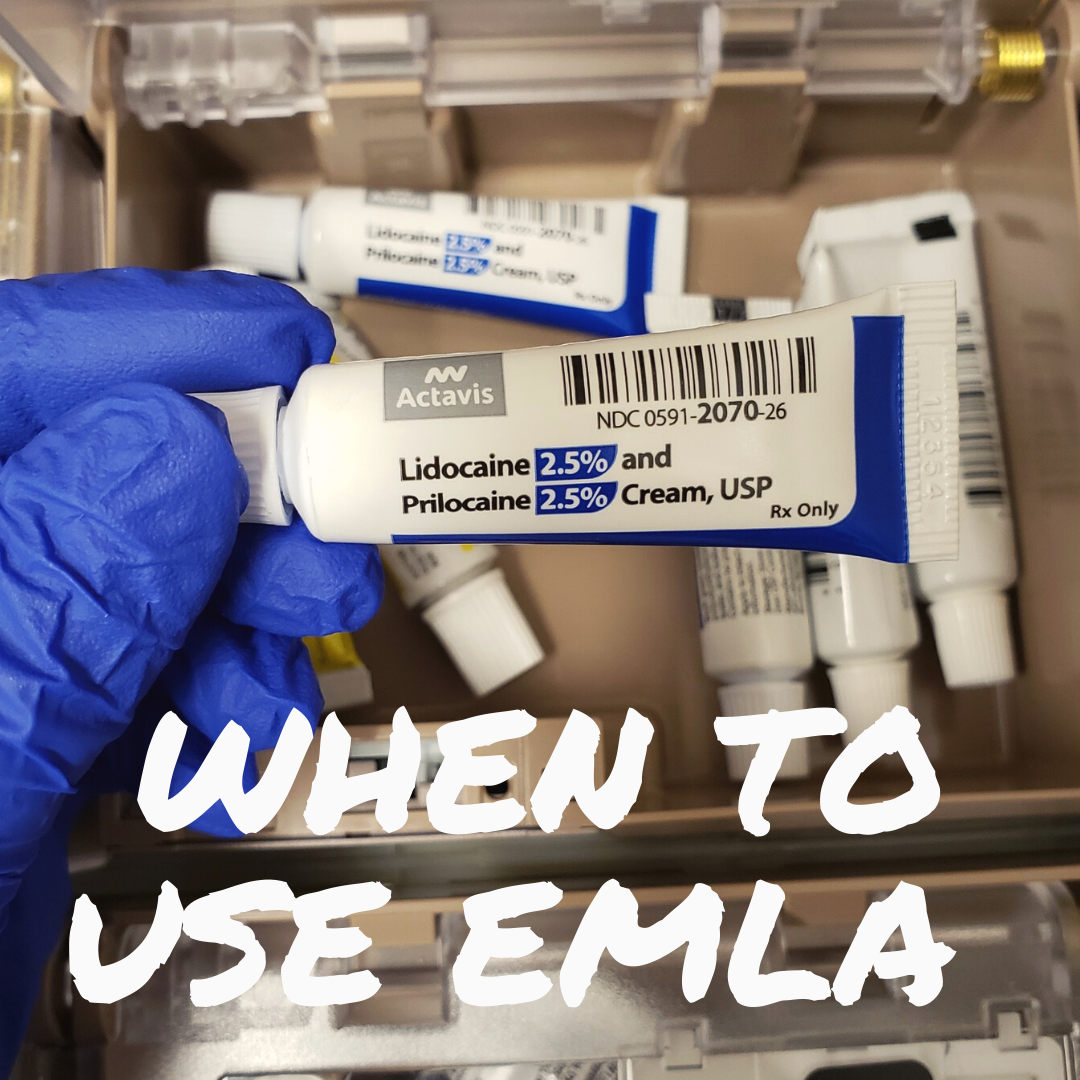What is EMLA and When Do You Use It?

Hello friends and Happy Medication Monday! Today we are talking Lidocaine and Prilocaine… mixed together you get EMLA, a cream used as a topical anesthetic. Many of you have probably heard of it while others have not so today we will be talking about what is EMLA and when do you use it.
What is EMLA?
Well, for those of you who want to (or already work) in an ER setting you will be seeing this medication a lot. As mentioned above, it is a topical anesthetic applied to the skin to numb certain areas before painful procedures.
When do you use EMLA?
EMLA is used prior to a skin procedure that may cause pain. This includes needle insertions for central or arterial lines, incision and drainages or skin laser surgeries. It can also be used for skin grafts.
It is important to note that skin MUST NOT be broken prior to applying EMLA. In other words, it is contraindicated to apply EMLA on any open wound.
You want to avoid using this product in the ears and around the eyes, mouth or mouth. You want to apply EMLA 1-2 hours prior to a procedure, time varying depending on the procedure. Some say a minimum of 30 minutes is enough for mild skin procedures but the rule of thumb should be 1 hour before needle sticks and 2 hours before skin procedures. The longer EMLA is kept on the better.
How to apply EMLA?
Let’s talk in the instance of an abscess. An abscess is an inflammation of the skin caused by a collection of pus guilty within the tissues of the body. This is usually caused by a bacterial infection. Abscesses usually are very red, warm and swollen and may require drainage. Before performing either manual decompression or an I&D you must numb the area to provide pain relief (it would just be so cruel to not only squeeze an infected area without any numbing medication but even worse, actually take a scalpel to the area. OUCH!) Remember, you must make sure the wound is closed and not already draining.
As long as it is intact, you will squeeze the prescribed amount of EMLA directly on the wound and the surrounding area and place an airtight dressing or tegaderm over it. Do not rub in the cream, just apply gently and place tegaderm over it.
Another example: Let’s say we will be performing an arterial line on the wrist. Sometimes a provider will order a local topical anesthetic to apply on the skin. You will apply EMLA to the wrist area to ensure it is numb enough and same as above, cover it with a tegaderm. You will then let it sit for approximately an hour and the provider will then wipe it off and clean area thoroughly prior to the procedure.
Things to consider:
Keep in mind, when applying EMLA on children you want to make sure you educate the parents and child not to touch the medicated area. The child should avoid touching the cream due to the risk of them putting cream into their mouth or eyes. To avoid this, especially with small children, you can apply a double dressing to ensure the child cannot access the cream or so the cream doesn’t seep through the dressing. If the medication gets into eyes, you must rinse the eyes immediately with water or saline and notify the provider.
Keep in mind, the area may remain numb for a couple hours (depending on how long you had the cream on). Patient will have limited sensation in this area and because of this you want to avoid any cold or warm compresses to avoid burns until feeling returns completely.
Well, there you have it! All you need to know about EMLA. Hopefully this gives you guys a little insight of what is EMLA and when do you use it. Have you guys had any experience applying EMLA to your patients? Share your stories below and make sure to follow HIPPA. I leave you with a few NCLEX questions to challenge your thought process!!!! I wanna see some answers in those comments!!! I’ll post answers later tomorrow. Let’s do this =)
NCLEX Questions
- General anesthesia can potentiate the effects of which of the following drugs?
A. Depolarizing agents
B. Skeletal muscle relaxants
C. Volatile liquids
D. Inhalation anesthetics - The most serious and critical metabolic side effect of general anesthetics during surgery is:
A. Hyperglycemia
B. Hyperthermia
C. Hypoglycemia
D. Hypothermia - Early signs and symptoms of local anesthetic toxicity include all of the following EXCEPT:
A. Tinnitus
B. Perioral numbness
C. Dizziness
D. Hypertension
Source: NursesLabs
’till next time,
The RN Educator
Share this:
Related Posts
What’s in a Pediatric Crash Cart? Nursing Students read NOW!
A pediatric crash cart is a mobile unit containing essential equipment and medications required for…
Share this:
How to Become a Confident Nurse
If you are anything like me, and let’s face it (like every nurse…



